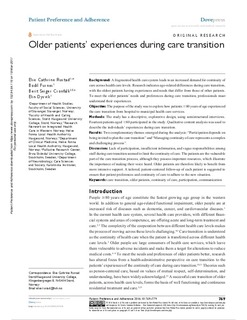| dc.contributor.author | Rustad, Else Cathrine | |
| dc.contributor.author | Furnes, Bodil | |
| dc.contributor.author | Cronfalk, Berit Seiger | |
| dc.contributor.author | Dysvik, Elin | |
| dc.date.accessioned | 2017-03-20T09:42:46Z | |
| dc.date.available | 2017-03-20T09:42:46Z | |
| dc.date.issued | 2016-05 | |
| dc.identifier.citation | Rustad, E.S.; et al. (2016) Older patients’ experiences during care transition. Patient Preference and Adherence, 2016:10 769–779 | nb_NO |
| dc.identifier.issn | 1177-889X | |
| dc.identifier.uri | http://hdl.handle.net/11250/2434652 | |
| dc.description.abstract | Background: A fragmented health care system leads to an increased demand for continuity of care across health care levels. Research indicates age-related differences during care transition, with the oldest patients having experiences and needs that differ from those of other patients. To meet the older patients’ needs and preferences during care transition, professionals must understand their experiences.
Objective: The purpose of the study was to explore how patients 80 years of age, or older, experienced the care transition from hospital to municipal health care services.
Methods: The study has a descriptive, explorative design, using semistructured interviews. Fourteen patients aged 80 or older participated in the study. Qualitative content analysis was used to describe the individuals’ experiences during care transition.
Results: Two complementary themes emerged during the analysis: “Participation depends on being invited to plan the care transition” and “Managing continuity of care represents a complex and challenging process”.
Discussion: Lack of participation, insufficient information, and vague responsibilities among staff during care transition seemed to limit the continuity of care. The patients are the vulnerable part of the care transition process, although they possess important resources, which illustrate the importance of making their voice heard. Older patients are therefore likely to benefit from more intensive support. A tailored, patient-centered follow-up of each patient is suggested to ensure that patient preferences and continuity of care to adhere to the new situation. | nb_NO |
| dc.language.iso | eng | nb_NO |
| dc.publisher | Dove Press | nb_NO |
| dc.rights | Navngivelse-Ikkekommersiell 4.0 Internasjonal | * |
| dc.rights.uri | http://creativecommons.org/licenses/by-nc/4.0/deed.no | * |
| dc.subject | older patients | nb_NO |
| dc.subject | care transition | nb_NO |
| dc.subject | continuity of care | nb_NO |
| dc.subject | participation | nb_NO |
| dc.subject | communication | nb_NO |
| dc.subject | kommunikasjon | nb_NO |
| dc.subject | eldreomsorg | nb_NO |
| dc.subject | eldre pasienter | nb_NO |
| dc.title | Older patients’ experiences during care transition | nb_NO |
| dc.type | Journal article | nb_NO |
| dc.type | Peer reviewed | nb_NO |
| dc.rights.holder | © 2016 Rustad et al. | nb_NO |
| dc.subject.nsi | VDP::Medisinske Fag: 700::Klinisk medisinske fag: 750::Geriatri: 778 | nb_NO |
| dc.subject.nsi | VDP::Medisinske Fag: 700::Helsefag: 800::Samfunnsmedisin, sosialmedisin: 801 | nb_NO |
| dc.source.pagenumber | 769—779 | nb_NO |
| dc.source.volume | 10 | nb_NO |
| dc.source.journal | Patient Preference and Adherence | nb_NO |
| dc.identifier.doi | 10.2147/PPA.S97570 | |

